Open 340-е the Auction and 26-й curator's auction "twenty-first century. Contemporary Russian art"
The master catalogue — 30 lots: 17 paintings, 8 of the original sheets and 1 — printed graphics and one lot in the categories of mixed media, porcelain, sculpture and digital print
the fee from buyers is 18 %.
Lots 340-го of the Auction presented in the exhibition online-выставки AI.
Lots 26-го curator of the auction "twenty-first century. Contemporary Russian art" presented in the exhibition online-выставки AI.
Dear participants and spectators of the auction AI! No monitor and no modern gadget ever authentic will not give works of art! Color, texture, not to mention the aura of a particular work, the impression from the meeting with her, the monitor is not subject. Good thing he can do at least wishy-washy, and not very good, on the contrary, to embellish (the last one we have, but it is fair to say it's worth). In addition, each person sees and feels by-своему. So come see all the work with my own eyes we have on Gorokhovsky, 7 (only need to call and make an appointment).

KLEVER Julius Yulievich (1850-1924) a Winter motif. 1880
dubbed Canvas, oil. 111,5 × 83,4
Russian art the end of the XIX — early twentieth century represents the canvas "Winter motif" (1880) Julius Yul'evich Clover, written perhaps in Germany, where the artist traveled in 1880-м to study landscape painting. "I write all sorts of landscapes, but-настоящему know a sunset in its different moments and gnarled trees, bent by bad weather and winds", — the artist wrote (artinvestment.ru). By the early 1880-х years, i.e. at the time of writing our "Winter motif" Clover is well established as an artist, finally gained their original creative vision and their own language. His landscapes can be rightfully attributed to the style of "romanticism", which was developed in Europe in the early nineteenth century as opposed to classicism and the Enlightenment. Romanticism in Russian painting — is primarily landscape, and not so much the image of nature as such, as the portrait area, with its own mood and character. In addition, for romantic landscapes characterized by a certain theatricality and dramatization of space, love the mysterious night lighting, the use of light (color) effects.
All this fully applies to the landscapes of Julius Yul'evich Clover in General, and to our "Winter melody." Despite the almost photographic realism, they often depict places invented that do not exist in reality. Clover and did not aspire to certainty — mainly it was to achieve the maximum expression of the picture. Here — is often fragmented asymmetrical type of composition, the view from the inside, which creates a sense of involvement and belonging to the majestic landscapes — untouched snow, impassable forest thickets, which likes to portray the artist. This participation of the eternal virgin nature set up the audience for a special lyrical mood and what was sought in the age of romanticism.
Love for dramatic effects in the many landscapes of the Clover is evident in his preference for early morning (sunset), almost night-lighting, careful study of the shades of the sky, reflections of light and colour reflexes in the water or on snow as well as the attention to silhouette, the contour, the individual color spots. (Read on the artist on AI: "artist of the week: Julius Klever".)
the Following section of the catalog — the works of Russian artists Abroad.

GONCHAROVA Natalia S. (1881-1962) Sketch formal dresses "Hierophant". 1920-е — beginning of 1930-х
Paper, charcoal, watercolor, gouache, pencil, silver and gold paint. 74,5 × 35,2
Sketch formal dresses "the Hierophant" in a 1920-х — the early 1930-х years Natalia Sergeevna Goncharova. The expert notes that "after leaving France, Natalia Sergeevna Goncharova, which has proven itself as a theater artist began to receive orders for the execution of sketches of women's clothing. In 1920-х years she collaborated with the fashion house Maria Myrbor Cuttoli, and with a number of other designers". Our dress — is "a sketch of a dress model", "sample graphic design artist". In his sketches 1920-х years, the artist combines the avant-garde in the work with the form of decorative motifs, referred to as Byzantine art and Russian folk art. In the styles of dresses dominated by antique silhouettes that fit perfectly into the aesthetics of the ar-деко. Some of the costumes embodied in the material, have survived to the present day. One of the dresses from this period is included in the collection of the Victoria and albert Museum in London.
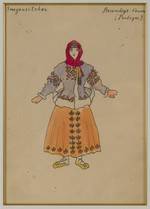
KOROVIN, Konstantin Alekseevich (1861-1939) Berendeyka. Costume design for the Opera N. Rimsky-Корсакова "the snow maiden". 1928
Paper, pencil, ink, pen, watercolour, whitewash, bronze paint. 25 × 17,9 (light)
Oh, fair Carnival!
Oh, fair Carnival! Oh! Oh!
Ranye-рано chickens sang,
about the spring was obvestila.
goodbye, goodbye, goodbye, Carnival!
Sweet, Bologna us fed,
mash, mash fed.
goodbye, goodbye, goodbye, Carnival!
Pitot, Gulian was plenty,
that shed more.
goodbye, goodbye, goodbye, Carnival! (libretto-oper.ru).
fashionable dress, Natalia Goncharova be theatrical graphics — costume design of Berendeyka to the Opera N. Rimsky-Корсакова "the snow maiden", performed Konstantin Alexeevich Korovin in 1928 for the first production of "Private Opera in Paris." Author's droppings in the figure indicates that this festive women's costume designed for the prologue of the Opera, which Berendei wires having fun at the carnival and meet Spring. Our Berendeyka — young girl (headband and scarf — details of the maiden suit), dressed in festive dress, the upper part of which is closed beautiful embroidered desagree.

LIPCHITZ, Jacques (1891-1973) sketch for the sculpture. 1939
Paper color (dyed), pastel, charcoal. 30,8 × 46,7
Dramatic and dynamic figure we see in the "Sketch sculpture" (1939) Jacques Lipchitz, today's hero "artist of the week". With the advent of the Nazis to power in Germany in the work of the sculptor was becoming more and more a thing of the past bright and cheerful motifs of the beginning of creativity and 1920-х and more were visible in the most terrible presentiments of coming time. Our study — work is very emotional.
the Next section — the work of Soviet artists.

RUBLEV Georgy Iosifovich (1902-1975) Landscape with trees and figure. 1920-е
Paper, pencil. 25 × 35
1920-ми years, started creativeheyday Georgi Iosifovich Rublev dated pencil drawing "Landscape with trees and figure." Personal exhibition held in the Tretyakov gallery in 2002-м, the centenary of the artist, opened a public unfamiliar face known in Soviet times by the author. "Georgi Iosifovich Rublev — character with unique avant-garde biography. A successful Soviet artist, lived until 1975. Stalinist muralist, wrote a huge ceiling in the style of Tiepolo with rosy happy Soviet people in the cloudless sky. And — is a very clever man — almost never showed his paintings. Except for two cases: in 1944, a small exhibition in the Union of architects (in military time, criticism was not too noticeable) and in 1969 the big man-to-man when it was shown almost all. But 1969 — is not current time, then the status of Stalinist monumental, the artist is not allowed to appreciate the avant-garde “for myself”, especially at that time have opened Falk and Filonov, not the second tier. Then, when it was opened. <...>
Perhaps the only difference from the other classics that have flourished in the thirties. All the categories of his poetics are shifted with respect to the values of the traditional avant-garde. He has no categories of truth, messianism, the opening of the first principles of the universe, he has no aspirations or calling to him, he has a sense of absurdity of being established" (kommersant.ru).
"Artist and writer Konstantin Sutyagin wrote that the paintings of the initial period of creativity, Rublev marked "energy of naïve art, its simplicity and power, disarming the viewer." But by the end of 1930-х years "Rublev turned off the soul, creativity," left "some brains" — said so in the discussion of his paintings in 1944-м year A. A. Fedorov-Давыдов" (lounb.ru). The last statement has become fashionable to quote in articles and even posts about the artist in our time — time impetuous and not always truthful praise of contemporaries, and citation may be questionable, but an abusive criticism of a bygone authors. But that's only the new owners Rublev heritage that-то not in a hurry to part with him, obviously agreeing that "the classic artists-авангардистам Rublev concerns about harms to Mayakovsky" (kommersant.ru).

LABAS Alexander Arkadievich (1900-1983) Airship over the city. 1932. Option
Paper, watercolor. 43,9 × 27,6
the watercolor Version of the song "Airship above the city" made in 1932 Alexander Arkadevich Labas. In the work Labasa — complex, multifaceted, very different — professionals, Amateurs and connoisseurs together to highlight the theme, where his power is absolute: the movement — everything that moves on land, water and air. "...The movement for the artist means first of all moving into a different space, even if it's not an airplane, but only a winch, carrying the painter to the top, but still tear it from the ground. We can say that the artist "wrote gravity" long before this word has literally walked in our everyday life..." (Yuri Molok, labasfond.ru). "...He's not sketching in the details of the airship or locomotive, he wrote the sense of wonder, speed, flight. The writing is not “the car”, but like its human consequences. And for that he needs the finestpainting, creating the impression full of light and color dynamic space, embracing, lifting everything inside it, — people, objects, vehicles and, it seems, the earth itself" (A. Morozov, labasfond.ru).

BUKH Aron Froimovich (1923-2006) Movement
oil on Canvas. 70,3 × 70,3
undated landscape "Movement" Aaron Froimovich Buch. Still lifes and landscapes it is widely acknowledged in the art world. The expressiveness of his full-scale works based on color and spatial transformation of reality. There's the usual riot of colors, no crazy color fullness other things of the artist. "The movement" presents us with a different facet of the work of Buch with color — not with bright colors and with a restrained, subtle and complex, but so is a huge palette. Buch does it as expertly as always.
the Following section of the catalog — the works of the sixties.
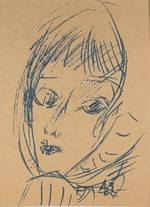
ZVEREV Anatoly T. (1931-1986) untitled (portrait of a girl in a headscarf). 1967
Paper, pen. The 38.5 × 28 (in the light)
Opens his wonderful drawing with felt-tip pen "untitled (Portrait of girl in kerchief)" (1967) Anatoly T. Zverev. The drawing is completed, signed, and perfectly conveys the freshness and charm very young girls.

BULATOV Erik Vladimirovich (1933) Restructuring. 1989
Paper, screen printing. 38,3 × 56,5 (sheet)
Draw works of the sixties — is such a huge reservoir of domestic art, which the researchers enough it for years and years to come to describe, explore and make discoveries. In circulation (by the way, printing, and porcelain) were plots and ready-made stuff that was for-настоящему interesting and important to its creators. However, sometimes copies were made completely new compositions. Artists like watched how to behave in this or that work, if it is to realize the porcelain plate, porcelain or sculpture, or in the printed schedule, for the manufacture of which there are many diverse techniques. Erik Vladimirovich Bulatov, the author prints "Perestroika" (1989), their limited edition items makes using the screen printing method, and we present today print is one of his most famous paintings.

PIVOVAROV Viktor Dmitrievich (1937) Bagatelles. Collection of 7 plates. 2007
Porcelain, hand-painted. Ø 32
One of the top-лотов auction — "Bagatelles", a collection of 7 plates (2007), painted by famous Czech painter on porcelain Jana Smejkalova sketches Victor D. Pivovarov, signed and with original drawings of the author on the back of the plates. "the Collection consists of seven plates: 1) the Rabbit flew away, 2) Formal shoes 3) Shit conceptualism sweet, 4) Joyful, melancholic, 5) Mouse of discourse, 6) two, 7) Moon and the truck. Thematically they can be divided into two groups — “theoretical” and “poetic”. You can also in all cases to say that it is poetry of paradox. After all, the mere fact that such words and images placed on the plates, there is already a paradox.
you Can also talk about the paradox of poetry, which, as a spirit can soar anywhere. And over the plate including. You can also not say anything. See hang on the wall or... to break into small pieces" (Viktor Pivovarov, Prague, 2007).
Onmeanings small image on the back of the plates AI when-то asked the artist. "What-то is symbolic in these small sketchbook next to the signature of no —, replied Victor Pivovarov. — Is a special bonus for collectors is that each plate is its own way unique. If the image on the front side of the plate is the same in all the copies, the image with the signature on the reverse of everywhere different. Motifs are sometimes repeated, but always a bit-чуть by-другому".

NEMUKHIN Vladimir Nikolaevich (1925-2016) composition with the map. 2008
Canvas on plywood, acrylic, pencil, playing card, collage. 58,6 × 69 (light)
As always, original and mysterious "Arrangement with the map" (2008) Vladimir Nikolaevich Nemukhin. This work is interesting to consider, to follow the author's idea author's decisions. Thing composite, multipart and busy. The artist in his own original style combined on the canvas, the many figures and characters, which take us back to the first Russian avant-garde, and to metaphysics 1960-х, and its main topic.
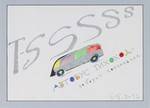
PEPPERSTEIN Pavel (1966) Bus-тихоход. 2015
Paper, watercolor, ink. 28 × 40,4 (light)
Not sixties in age, but certainly close to him by blood and spirit the author, Pavel Pepperstein presented in the catalog conceptual watercolor "Bus-тихоход" (2015). Texts as full-fledged elements introduced into his paintings and Kabakov, and Bulatov, and Brewers, and other artists. "Bulatov and Kabakov. For both these artists, the topic word/image is in a sense Central, both start from rather similar conditions for its interpretation and at the same time come to a relatively different result" (Boris Groys, di.mmoma.ru). Texts Pivovarov and Pepperstein — are different, they are impossible without images (like Kabakov) and solve spatial problems (as Bulatov), they support the image, gives it new qualities. Watercolor "Bus-тихоход" — another experiment by Pavel Pepperstein from the text. It was funny and interesting.
Traditionally the final and non-traditional the largest and most diverse section of the directory — of the work contemporary authors.
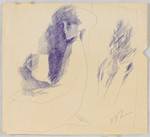
Rustam KHAMDAMOV U. (1944) In the teahouse. 1970-е
Paper, ballpoint pen. 26,7 × 29,1
1970-ми years Dating expert easy graceful figure "In the teahouse" Rustam Khamdamov U., a recent hero in our traditional rubric "artist of the week".

GRIGORIEV E. Alexander (1949) the Fragmentation of No. 1. From the series "Fragmentation". 1978
Paper, tempera. 29,3 × 38,9 (light)
Tempera on paper in the author's style of kinetic mannerism says "Fragmentation No. 1" (1978) from the series "Fragmentation" Alexander Yefimovich Grigoriev. Mechanistic fragmentation emphasizes the elegance of a stylized butterfly. The work is written 6 years after the release Grigorieva from the group of Russian kinetists "Movement" led by Lev Nusberg; five years of participation in the group (1967-1972) was the most interesting period in the artist's life and certainly influenced his future work.
"We were friends, shared everything and looked into each other's work. Had an interesting life, although wewere all alone. Nothing like no one else did... Until we have reached fragmentary information about the Western kinetic art — and we accepted Russian equivalent of the term "Movement"" (interview with Francisco Infante, member of the "Movement"). "Kinetische longed to overcome the real art of aesthetic objects and static structures. Constructivists 20-х years understood the movement not only as a mechanical movement, but also as a form of perception of time and space, the movement as a universal position. Hence thesis Nusberg, confirmed the entire group: “I want to work with electromagnetic fields, with glowing and pulsating concentrations in space, with various movements of flows of gases and liquids, mirrors and optical effects, with changes of heat and smells ... and, of course, music.” In the text of the program in 1965 under the title “What is kinetic art?” Nusberg determines the kinetic of the synthesis: "...we require the use of all opportunities and resources, both technical and aesthetic, physical and chemical phenomena, all arts, all processes and forms of perception, as well as the involvement of the mental reactions and the influence of various sensory capabilities of a human, as a means of artistic expression"" (quartagallery.ru). Grigoriev joined the group in 1967 (left the group in 1972-м) and managed to participate in several of her projects. To the same period belong his first works in the style of abstract-геометрической minimalist painting and kinetic spatial objects (alegrig.ru).
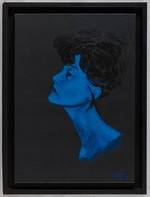
Paata MERABISHVILI, Marasovic (1964) bell. 2008
Artificial leather, acrylic. 69,7 × 49,8
Brush Paata Merabishvili marasovich of belongs to the portrait of "Bella" (2008): on the black faux leather acrylic-written inspirational image of Bella Akhmadulina.

LANG Oleg Vladimirovich (1950-2013) the Drummer. 2013
acrylic on Canvas. 54,6 × 45
Fun walks "the Drummer" (2013) Oleg Vladimirovich Langa. "Free and independent, he was not trying to fit into mainstream, to meet someone-то expectations. His signature style, which he was correct at every step of the way, mixed with the appeal to urban folklore, combines primitive expressionism, minimalism" (saratov-room.ru). Oleg lang — artist "Museum", "dozens of his canvases are in the permanent collections of many Russian museums, including the Tretyakov gallery and the Russian Museum, and were shown in solo exhibitions" (mmoma.ru).
"From lang items tend to be irrelevant, so at home, and face, and large pieces United by a common still-life approach. Where originates this setting? In the Moscow painting ten years of the last century — artists “Jack of diamonds”. According to their contemporaries, the critic Sergei Makovsky, “the jacks” first “in landscape, and in the face of a man, and nakedness saw the interaction of the painted trekhmernoi. The portrait is likened to the still life and Vice versa... Topographic fidelity to nature, and abstraction, generalization"" (lookatme.ru).
"Kind of developing the traditions of good old avant-garde, Oleg lang has developed his own, individual style in which expressionist stylecombines abstract and figurative elements... <...> Painting of Langa, despite the conventionality of its language, is not directed to metaphysics, and to real life. His compositions are remarkable for their overwhelming freedom, a clever play of textures, intense color spots, independent of spatial-образующая line. Metaphors unexpected, as the original rhymes. Healthy creative fun combined with tragedy. Creativity and the whimsical decisions invariably surprised, and-за "chaos thickets" scenic instrumentation emerges something profound, inexplicable, infinite" (erarta.com).

NESTEROVA Natalia I. (1944) the Season of oysters. 2013
oil on Canvas. 60 × 81
In 2013 in France says "the Season of oysters" Natalia Igorevna Nesterova. "My friends hanging awesome work Dima Plavinsky, which depicts the sink. It is a shimmering miracle — is akin to Vrubel. I would like to have my oysters were the same. Still does not work. However, for oysters I has not lost interest — no gastronomy, nor in artistic terms" (Natalia Nesterova, portal-kultura.ru). As usual Nesterova, a person models semi-rotation of the head. Significant hands with oyster shell and lemon, which now squirts into the sink, the juice, the smell will combine with a delicate scent of blooming chestnut on the table in a cafe. The dish is full, hand first oyster — last moment of anticipation of bliss...

SAIRANEN Andrei (1961) the chimes will be heard soon
oil on Canvas. 137 × 56,5
Undated oil on canvas "the chimes will be heard soon" Andrei Nikolaevich Sabianina reminds us that before the New year only a little over five minutes as the cute song from "Carnival night" and you have to do a lot more: time to reconcile those who quarrel, time to say what is not said, without postponing for a year...
Five minutes... Five minutes...
The chimes will be heard soon...
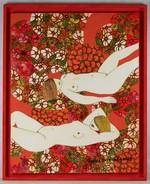
VORONOVA Lucy (Ludmila Vladimirovna, 1953) apples of Paradise. 2019
oil on Canvas. 100 × 80
Canvas "Paradise apples" (2019) Lucy Raven written in the current, a happy period of creativity of the artist. Flower beds, mountains funny red apples and two naked female figures — symbols of freedom, both spiritual and physical (this duality underlines the fact that Luce both figures are posed, obviously, one model). Freedom to be ourselves, freedom from the obligations and painful thoughts, the freedom to enjoy the warmth, the sun, the freedom to create and own hands to produce good joyful world their creations. An earthly Paradise, and Paradise apples grew on the earth the Apple tree — but to rain on the meadow. Work exhibited the art.

ARCHIPENKO Daniel A. (1985) the Observer. 2020
oil on Paper. 37,7 × 49,5
Completes our story of oil Daniil Aleksandrovich Archipenko "the Observer" (2020).
at the same time with our staff 340-м AI Auction open 26-й auction "twenty-first century. Contemporary Russian art". The catalogue contains artworks of Seeds Agroskin, Andrey Bisti, Vladimir Brainin, Lidia Vitkovskaya, Dima Goryachkin, Natalia Garnovskii, Igor Kislitsin, Alexander Savko, Andrey Chukanova, Natalia Turnovo.
All the best of luck on 340-м AI-Аукционе and 26-мauction "twenty-first century. Contemporary Russian art"!
Fair market price level on the works of the authors represented in the catalog of this auction can be identified in the information database of auction results ARTinvestment.RU.
the auction AI continues to operate a virtual party "Reserve price is not reached". He appears in the final minutes of trading, so that customers have the option to kill the reserve price (for those items where it is). In other words, if you see party "Reserve price is not reached," that is a reason to continue the fight — perhaps the victory is near.
If the latter rate appears accompanied litters "Until reserve was 1 step", it means that making the next bet, you win the auction — unless, of course, who-нибудь, inspired close luck not interrupt your last words. And always a shame when participants traded a few days and especially the last couple of hours excitedly before closing suddenly stop just one step from victory. If you feel that thing — is yours, so take this step!
fee from the buyer is 18 % of the final price of the lot.
***
We continue to make paintings and drawings (original and lottery) to our regular weekly auctions. About his desire to put the thing on the auction AI write info@artinvestment.ru or call: 7 (495) 632-16-81. Rules of submission for auction AI can show sdes.
***
Regular auction of art and collectibles are conducted using an automated auction bidding system, available at https://artinvestment.ru/sales/.
In normal mode, each online-аукцион lasts for four days. But if the rate on a-либо lot done in less than 30 minutes before closing Internet-аукциона, the bidding for this lot will automatically be extended for another 30 minutes. After these 30 minutes, if not received the new rate, Internet-аукцион will be closed — otherwise it will be extended for an additional 30 minutes. Such a trading mode, as shown, making pointless attempt to postpone rates until the last seconds before the closing of the auction and encourages participants to bid in comfort mode during all days of the auction.
According to auction Rules, to participate in the auction, ie to bid on the proposed lots for sale may only individuals who register on the site Auction (Auction administration reserves the right to test applicants and to refuse registration without explanation).
fee from the buyer AI Auction is set at 18% of the final price of the lot. Payment is made in rubles in cash in the office of the Auction or by wire transfer to the account of the Auction. The Auction gives buyers of permits for export outside Russia of goods purchased at auction, and does not guarantee the possibility of obtaining such permits. Sending lots outside of the Russian Federation the administration of the Auction is not possible.
***
ARTinvestment.RU — information-аналитический resource on the art market, the developer of a family of indices of the art-рынка and compiler ARTIMX the world's largest database of auction results for artists outside the orbit of Russian art. In hisanalytical work ARTinvestment.RU relies more than 250 million auction sales results for 13 thousand of Russian artists in the segments of painting, drawing and sculpture. Unique indicators of investment risk assigned by the experts ARTinvestment.RU help exclude many of the estimated mass of questionable results.
Permanent link to:
https://artinvestment.ru/en/news/auctnews/20200728_auctionAI.html
https://artinvestment.ru/news/auctnews/20200728_auctionAI.html
© artinvestment.ru, 2025
Attention! All materials of the site and database of auction results ARTinvestment.RU, including illustrated reference information about the works sold at auctions, are intended for use exclusively for informational, scientific, educational and cultural purposes in accordance with Art. 1274 of the Civil Code. Use for commercial purposes or in violation of the rules established by the Civil Code of the Russian Federation is not allowed. ARTinvestment.RU is not responsible for the content of materials submitted by third parties. In case of violation of the rights of third parties, the site administration reserves the right to remove them from the site and from the database on the basis of an application from an authorized body.

